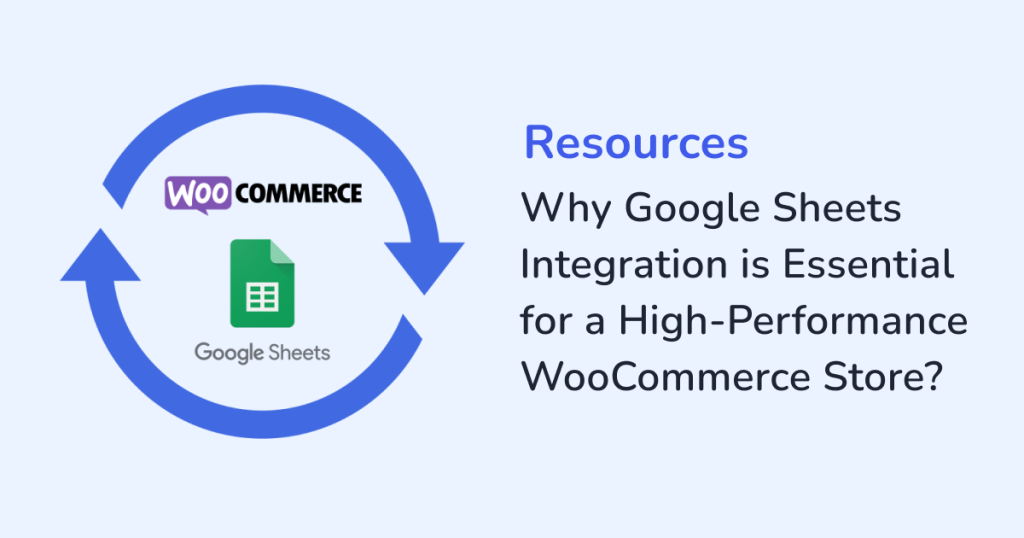
Running a WooCommerce store involves more than just listing products and processing payments. As the store grows, the complexity to manage the following data increases:
- Orders
- Inventory
- Customer data
- Performance metrics
That’s where Google Sheets integration can make a massive difference. In this article, we’ll walk through 11 reasons why syncing your WooCommerce data with Google Sheets is critical for improving efficiency and reducing manual errors. Also, this Google Sheets integration helps to unlock new levels of insight and growth. Especially if you’re using a plugin like WPSyncSheets For WooCommerce, the process is smooth, fast, and completely no-code.
Why Connect WooCommerce to Google Sheets?
Google Sheets is a dynamic spreadsheet. It’s a cloud-based workspace that allows your whole team to access and update the data in real-time. When connected with WooCommerce, it helps you:
- Centralize your store’s data and operations
- Streamline workflows without relying on expensive custom development or external CRMs
Here’s why that integration is crucial:
1. Real-Time Order Tracking Made Simple
WooCommerce generates order data every time a customer makes a purchase. With Google Sheets integration:
- All order details, including customer name, order total, product name, shipping status are synced automatically.
- Your support and fulfillment teams can view live data and eliminate delays or miscommunication
- You can quickly spot trends or high-performing products by building dashboards or pivot tables.
Pro Tip: WPSyncSheets For WooCommerce supports real-time sync, meaning every new order is pushed to your sheet the moment it’s placed.
2. Centralized Inventory Management
Inventory management can get chaotic, especially with multiple products or suppliers. By syncing inventory data with Google Sheets, you get a centralized stock view across product lines or categories. This makes it easier to:
- Track stock levels
- Adjust quantities as needed
- Share data or updates with your team
You can also set up out-of-stock and restock alerts using built-in Google Sheets formula. This is especially useful for store owners who also sell offline and want unified stock tracking.
3. Making Data Sharing Easy for Everyone
Sales, marketing, accounting, and support all need access to WooCommerce data—but not everyone should be poking around your WordPress dashboard. That’s where linking up with Google Sheets really helps. With it, you can:
- Share specific spreadsheets with each team
- Decide who gets to view, comment, or edit by setting permissions
- Everyone stays in the loop with live updates and comments
So, no more juggling manual exports or emailing CSV files back and forth. It makes sharing data across teams way simpler and smoother.
4. Powerful Reporting and Analytics
While WooCommerce provides basic reports, Google Sheets lets you go further by:
- Using formulas, filters, and pivot tables to analyze:
- Sales trends
- Top customers
- High-return items
- Creating visual dashboards with:
- charts
- conditional formatting
- Connecting with Data Studio for advanced business intelligence.
The insights you gather here can inform everything from pricing strategy to marketing spend.
5. Reduced Human Errors and Manual Work
Manually exporting WooCommerce data takes time and copying order details by hand leaves too much room for errors. With an automated sync:
- Data entry errors are eliminated.
- Reports stay up to date without staff involvement.
- You save hours and avoid costly mistakes.
Plugins like WPSyncSheets automate this entire flow. This gives time to focus on growth.
6. Easy Backup and Audit Trail
Google Sheets automatically keeps the version history and backups of your synced data. So, you have a time-stamped record even if a plugin conflict or database crash happens. This results in reconciliation and easier audits when working with external partners or accountants.
7. No-Code Integration with WPSyncSheets For WooCommerce
Even non-technical users can set it up in minutes. Therefore, you don’t need to hire a developer. The WPSyncSheets For WooCommerce plugin offers:
- One-click authentication with Google
- Custom mapping of fields. Fields include order ID, customer details, product name, etc.
- Support for syncing orders, products, customers, and coupons data.
- Compatibility with WooCommerce:
- Subscriptions
- Order notes
- Custom order statuses
8. Automated Workflows with Other Google Tools
When your WooCommerce data syncs with Google Sheets, you can do a lot more smart activities. Some of these smart automations are:
- Using tools like Google Apps Script or Zapier to:
- Send notifications
- Generate invoices
- Push updates to Slack
- Automatically sending email daily sales reports.
- Triggering conditional actions based on order value or product type.
The possibilities are endless and fully customizable without custom code.
9. Sync Data Across Channels
If you’re selling on multiple platforms—like Shopify, Amazon, or offline—Google Sheets can act as your unified control panel.
- Import data from different platforms into one sheet.
- Analyze overall business performance in one place.
- Coordinate stock and orders across all channels.
Google Sheets becomes your business command center.
10. Scalability Without Complexity
As your store grows, things can quickly get more complex. Google Sheets are built to scale with you and can handle thousands of data:
- without slowing down.
- making it a reliable choice as your operations expand.
Additionally, you don’t need to invest in a costly CRM or ERP to manage complex workflows. With Google Sheets, you can:
- Build layered reports tailored to your business needs
- Use filters to keep the bulk data clean
- Save time by automating routine tasks
All of these features reduce manual work and scale stores without complexity. Thus, we can say that Google Sheets scales with your:
- Team
- Store
- Strategy
11. Better Customer Support and Order Management
When support teams have quick access to live order data, response times improve—and mistakes drop.
By connecting the WooCommerce data to Google Sheets:
- Your support staff can view the order details without logging into the backend.
- Refunds, replacements, or custom support workflows can be handled faster.
- You can create a shared tracker for pending issues and returns.
This improves both internal coordination and customer experience.
Use Cases for Google Sheets + WooCommerce
Here’s how store owners use this integration:
- Track order statuses: : By analyzing which orders are pending, shipped, and delivered.
- Spot your customers: By using the purchase data to segment buyers and send personalized offers.
- Inventory restocking: Quickly identify fast-moving products.
- Team handoffs: Share order data with different teams including, shipping, accountants, or customer service.
Wrapping Up
If your WooCommerce store is growing, manual workflows won’t scale with you. Google Sheets integration helps you take control of your data. That too, without the complexity or cost of large-scale ERP systems.
So, integrating WooCommerce with Google Sheets makes your store more efficient, responsive, and ready for growth. And, helps in:
- managing hundreds of orders
- tracking real-time inventory
- collaborating with your team
Thus, install WPSyncSheets for WooCommerce and get started in minutes.
FAQs
1. What kind of data can I sync from WooCommerce?
You can sync orders, products, customers, coupons, order notes, and more.
2. Will this integration slow down my site?
No. WPSyncSheets is optimized for performance and uses asynchronous sync methods to avoid impacting load times.
3. Can I choose what fields get sent to Google Sheets?
Yes. You can map only the fields you want—like order ID, status, product name, or payment method.







